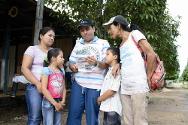Colombia: Weapon contamination
10-07-2013 Feature
Many victims of weapon contamination in Colombia have had to leave their homes, have lost their livelihoods or the physical ability to perform a job and are struggling to cope with the serious physical and psychological consequences of their injuries.

In communities affected by weapon contamination, people are taught how to stay safe.
© ICRC / M. C. Rivera
Weapon contamination affects the everyday lives of communities in conflict areas. It hampers people’s movements around the area and restricts their access to schools, crops and water sources. It also causes injury, disability, death and displacement.
The scale of this problem, caused by improvised explosive devices, which are activated like anti-personnel mines, and explosive remnants of war, such as unexploded or abandoned munitions, increases day by day as the armed conflict and violence continue, with effects that extend far into the future. The situation in Colombia is particularly alarming, because newly contaminated areas are added to those contaminated in the past, claiming new victims.
The presence of improvised explosive devices and explosive remnants of war is common in rural areas where fighting, bombardments and military operations are taking place. Factors such as the manual eradication of illegal crops and the struggle by armed groups to control natural resources have led to the problem becoming particularly acute in certain areas of the country. Weapon contamination is not, however, confined to rural areas, but is also evident in urban areas affected by situations of violence involving the use of explosive devices and small and light arms.
Juan’s fight for life
 Carmen came out of the kitchen when she heard the commotion and saw her son lying on the ground covered in blood, taking what she thought was his last breath. She picked him up and began to run without stopping – she does not know exactly how long, but it was several hours – until she found someone to help her... Read more
Carmen came out of the kitchen when she heard the commotion and saw her son lying on the ground covered in blood, taking what she thought was his last breath. She picked him up and began to run without stopping – she does not know exactly how long, but it was several hours – until she found someone to help her... Read more
Prevention and community training in Medellín
 Armed fighting among street gangs known as “combos”, invisible borders which restrict movement to just a few blocks and hamper everyday activities such as going to class or work, threats against health personnel which limit people’s access to health services and stray bullets that kill and maim dozens of people each year; these are just some of the consequences of the armed violence suffered by residents of various districts in Medellín... Read more
Armed fighting among street gangs known as “combos”, invisible borders which restrict movement to just a few blocks and hamper everyday activities such as going to class or work, threats against health personnel which limit people’s access to health services and stray bullets that kill and maim dozens of people each year; these are just some of the consequences of the armed violence suffered by residents of various districts in Medellín... Read more
Victims’ voices
“My son died and I was injured”
“Before this happened to me, I worked in the country. I had a good farm and had worked it with my family for 23 years. One day, I went out with my son to move cattle from one field to another and the boy went running ahead and found a device. When he touched it, it exploded and killed him outright. I was about twenty metres away when it happened and was hit by the blast. That was it for him. I was badly injured, and my neighbours managed to get me to San Vicente. From there, I was moved to the hospital in Florencia, where I stayed for 29 days, feeling completely lost. The situation has been very difficult for me since then, because it’s not easy when you are out of your element. I still have to have another operation too.”.
Héctor Marín Perdomo, resident of a rural area in Caquetá
The ICRC’s humanitarian response
In 2012, the ICRC maintained contact with communities affected by the armed conflict in order to assist victims of weapon contamination and carry out prevention activities.
The ICRC and the Colombian Red Cross held 317 workshops on keeping safe and the rights of victims for some 7,990 people living in areas affected by weapon contamination.
Some 200 civilian victims of weapon contamination received advice about how to access State services and obtain compensation for the injuries and harm they had suffered. One of these victims is 62-year-old Abel who lost his 13-year-old son in the explosion of an explosive remnant of war in the region of Catatumbo. The ICRC, in addition to covering the cost of the funeral, accompanied Abel throughout the process to claim compensation from the government, helping him with the formalities and paperwork.
Through confidential dialogue, the ICRC reminded all the parties to the conflict of the harm that improvised explosive devices and the explosive remnants of war can cause to civilians and tried to encourage activities to improve the lives of communities affected by weapon contamination. These efforts were supplemented by risk-reduction activities, including farming projects and the reconstruction of infrastructure, such as schools and sanitary facilities, destroyed by weapon contamination.
In 2012 the ICRC and the Colombian Red Cross continued to cooperate with local and national institutions working in the country’s most contaminated areas. The purpose of this cooperation is to strengthen integrated assistance for victims, raise awareness about their rights and carry out prevention activities. They also worked in coordination with the Presidential Programme for Comprehensive Action Against Anti-personnel Landmines (PAICMA) in the areas of information management, assistance for victims and prevention.